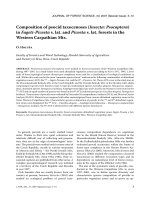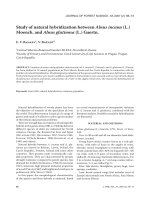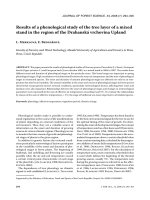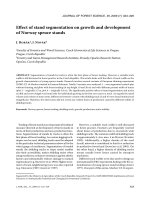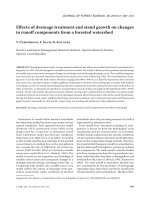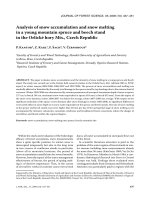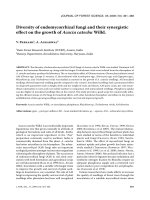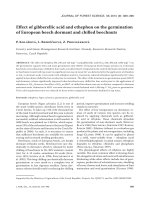Báo cáo lâm nghiệp: "Effect of stand segmentation on growth and development of Norway spruce stands" pps
Bạn đang xem bản rút gọn của tài liệu. Xem và tải ngay bản đầy đủ của tài liệu tại đây (208.49 KB, 7 trang )
J. FOR. SCI., 55, 2009 (7): 323–329 323
JOURNAL OF FOREST SCIENCE, 55, 2009 (7): 323–329
Tending of forest stands is an important silvicultural
measure directed at development of forest stands in
terms of their production and non-production func-
tions. Segmentation of stands by tracks is often the
first phase of forest tending. As various logging tech-
niques can be used, skidding tracks must be adapted
to the particular technical parameters above all to the
wheel gauge of machinery. Segmentation of tended
stands (by skidding tracks or slope roads) enables
also their accessibility, makes skidding easier when
using machinery, enhances resistance against abiotic
factors and substantially reduces damage to natural
regeneration (e.g. B et al. 1992). Higher incre-
ment of track-neighbouring trees was also reported
(e.g. E 1987; C 1997).
However, a suitable track width is still discussed
in forest practice. Foresters are frequently worried
about losses of production due to excessively wide
skidding tracks. e common width of skidding track
is approximately 3–4 m, max. 5 m (R, B
1982). Additionally, a higher density of the road
(track) network is considered to lead to a reduction
in productive forest land (J et al. 2001). On
the other hand, a higher density of skidding tracks
means usually lower losses caused by transport
machinery.
Different track widths were also used to design an
international IUFRO experiment dealing with the ra
-
tionalization of young spruce stand tending (A
1977). One part of this series, Machov CZ 14 experi-
Effect of stand segmentation on growth and development
of Norway spruce stands
J. H
1
, J. N
2
1
Faculty of Forestry and Wood Sciences, Czech University of Life Sciences in Prague,
Prague, Czech Republic
2
Forestry and Game Management Research Institute, Strnady, Opočno Research Station,
Opočno, Czech Republic
ABSTRACT: Segmentation of stands by tracks is often the first phase of forest tending. However, a suitable track
width is still discussed in forest practice in the Czech Republic. is article deals with the effect of track width on the
growth characteristics of young spruce stands. Research involves several variants of European thinning experiment
IUFRO CZ 14 Machov situated in Eastern Bohemia. Totally 3 variants were analyzed: 1 – non-segmented control plot
without thinning and plots with forest tending (at top height 10 and 20 m) and with different present width of tracks
(plot 3 – originally 3.5 m, plot 4 – originally 5.0 m). e significantly positive effect of stand segmentation and tracks
on dbh and crown length was found only for individuals growing in the first row next to a track. As regards the stand
volume and volume of mean stem, differences between variants with skidding track (3 and 4) were found minimal and
insignificant. erefore, the observation did not reveal any evident losses of production caused by different widths of
skidding tracks.
Keywords: Norway spruce; forest tending; skidding track; growth; production; static stability
Supported by the Ministry of Agriculture of the Czech Republic, Research Project No. MZE 0002070203 Stabilization of Forest
Functions in Anthropically Disturbed and Changing Environmental Conditions.
324 J. FOR. SCI., 55, 2009 (7): 323–329
ment, was established in Eastern Bohemia in 1971
(C 1981).
e aim of our study was to detect possible ef-
fects of stand segmentation (using skidding tracks
of different width) on the growth and development
of experimental Norway spruce stands. e analysis
was focused on possible production losses caused by
stand segmentation as well.
MATERIAL AND METHODS
Experimental series Machov CZ 14 is situated in
Natural Forest Area 024 – Sudeten Piedmont (e
Broumovská vrchovina Hills) within the territory
of the former forest enterprise Broumov, at present
in private ownership (C 1981; S
1998). e climate of this area is mildly temperate
but mostly very wet or wet. Average annual air tem-
perature ranges between 6 and 7°C, average annual
sum of precipitation ranges from 700 to 900 mm.
Spruce monoculture is the first forest generation
under conditions of the former meadow situated
on the plateau at the elevation of 700 m; the stand
was planted in 1965 (S 2006). Soil type is
Albeluvisols – Gleysols to Stagnosols, forest type
Abieto-Fagetum illimerosum acidophilum – Carex
pilulifera with possible slight transition to Piceeto-
Fagetum illimerosum acidophilum – Calamagrostis
villosa (V 2002).
e experimental series Machov was established
in a regularly-spaced spruce thicket in 1971. e
stand was 6-years-old reaching the top height of
1.2 m with initial density of 7,700 trees per 1 ha.
Respecting the programme of international IUFRO
experiment, the initial density of the culture was
reduced to 2,500 trees/ha. e experimental series
consists of five thinning variants, each repeated
twice. e plots were designed as rectangles 25 m
by 40 m (0.1 ha). e main aim of the experiment
has been to test three different thinning strategies
compared with two plots (number 1 and 6) left as
control. In these plots no tending operations have
been conducted; only dead trees were removed
(S 1998).
Three experimental plots were chosen for this
study:
– 1 – control plot with the original spacing of
2,500 individuals per hectare, where only dry and
broken trees were removed,
– 3 and 4 – plots with very heavy thinning in the
young stage followed by postponing further ope-
rations into the phase when the stand reaches
the top height h
dom
20 m. Programme 4 differs
from programme 3 only in the simulation of
machinery use and consequently in the width of
tracks.
Until then (2007, age of 42 years) the following
tending operations were done in accordance with the
programmes on variants 3 and 4 (Fig. 1):
– h
dom
being 10 m (age of 20 years, year 1985),
– h
dom
being 20 m (age of 36 years, year 2001).
ese dendrometric characteristics were recorded
in each plot: diameter at breast height (dbh in cm)
measured in two perpendicular directions (firstly
from the East and secondly from the North), height
(h in m) and crown length (in m). e position of all
trees was also surveyed in the chosen plots. dbh data
were always acquired using a calliper (with mm cali-
bration). Height and crown length (from the lowest
whorl that has at least 3 vital branches to the top of
tree) of each tree were measured with the Blume-
N
500
1,000
1,500
2,000
2,500
3,000
15 20 25 30 35 40 45
Age (years)
Number of trees per
hectare
1
3
4
G
10
20
30
40
50
60
15 20 25 30 35 40 45
Age (years)
Basal area (m
2
) per hectare
1
3
4
Fig. 1. e number of trees and basal area development in observed plots of spruce thinning experiment IUFRO CZ 14 Machov
at the age of 20–41 years (1 – control plot without thinning and tracks, 3 and 4 – plots with thinning and tracks, see Methods
for more details)
Basal area (m
2
/ha)
No. of trees/ha
J. FOR. SCI., 55, 2009 (7): 323–329 325
Leiss altimeter and 4 m pole. Tree position was sur-
veyed using a 50m tapeline, being regarded the fact
that trees are planted in rows parallel to the track.
Other variables were calculated from the measured
data: slenderness quotient (h/d) and symmetry of
dbh cross-section (calculated as the ratio of dbh
from the first measurement to dbh from the second
measurement).
We divided each observed variant into four blocks
(area of 0.025 ha) to analyze stem volume. e cal-
culation of volume over bark (for each stem) was
based on diameter (dbh) and height h using tables
(L 1952).
e design of IUFRO experiment (A 1977)
defines the width of tracks as follows: variant 1
– without track, variant 3–3.5 m and variant 4–5 m.
e actual (present) width of tracks was determined
by means of surveyed positions of trees (and their
rows) and reconstructed axis (centre) of the track
in plot 3. e only exception was plot 4, where the
track axis did not follow a parallel direction to the
rows of trees. Average width of track was calculated
according to Finnish methodology (U et al.
2002) using a 4m measuring rod.
One-way analysis of variance (p ≤ 0.05) was used to
process measured data using the software Statistica.
RESULTS
Contrary to the initial status, different track widths
were found in the investigated plots. Except for con-
trol plot 11 (no tracks) the track width of 5.6 m was
found in plot 3 (initial width of 3.5 m) and 6.8 in plot
4 (initial width of 5 m). Tracks are thus wider than
the methodology of the trial demands. e reason
is above all that the distance between stems was
measured in closing thicket instead of in crowns.
However, the present track dimensions can be used
to analyze the dependence of investigated variables
on the track width.
Table 1. Characteristics of group of trees, which grow in rows with different distance from central axis of the control
plot 1 (age of 41 years)
Row* Plot 1
Diameter d
1.3
(cm)
Height (m) Crown length (m)
Quotient
of slenderness
Symmetry
of stem in d
1.3
1 (2.6)
mean 20.90a 19.70a 7.10a 0.960a 0.60a
S.D. 5.32 2.74 2.72 0.140 0.36
2 (5.2)
mean 19.10a 18.50a 6.00a 1.000a 0.60a
S.D. 4.87 3.71 2.84 0.180 0.47
3 (7.8)
mean 20.50a 18.60a 6.20a 0.940a 0.60a
S.D. 4.60 3.02 2.69 0.120 0.44
*Distance from the skidding track (m)
Significant differences (p ≤ 0.05) are designated by different letters in columns
Table 2. Characteristics of groups of trees which grow in rows at different distance from the skidding track on plot 3
(age of 41 years)
Row* Plot 3
Diameter d
1.3
(cm)
Height (m)
Crown length
(m)
Quotient
of slenderness
Symmetry
of stem in d
1.3
1 (2.8)
mean 27.90a 21.40a 12.50a 0.750a 1.10a
S.D. 6.58 3.36 2.61 0.100 0.94
2 (5.4)
mean 24.70b 21.10a 10.10b 0.870b 0.80a
S.D. 4.92 2.57 2.57 0.100 0.81
3 (8.0)
mean 25.00b 21.10a 9.50b 0.830b 0.70a
S.D. 5.08 2.03 2.54 0.120 0.77
*Distance from the skidding track (m)
Significant differences (p ≤ 0.05) are designated by different letters in columns
326 J. FOR. SCI., 55, 2009 (7): 323–329
Comparison between rows
It was confirmed in control plot 1 (where no
tending and tracks were realized) that no observed
variable (dbh, height, crown length, h/d ratio and
symmetry of stem) was significantly influenced by
tree position – particularly with respect to a dis-
tance from the central axis of the plot (Table 1).
e significantly highest average diameter of in-
dividuals (27.9 cm) growing in the first row next to
the track was found in plot 3 (track width of 5.6 m)
in comparison with individuals situated in more dis-
tant rows (the second and the third row – 24.7 and
25.0 cm, respectively, Table 2). Consequently, we
found a significantly lower h/d ratio (0.75) and signifi-
cantly longer crowns (12.5 m) for trees growing in the
first row (next to the track) in comparison with the
group of trees from the second and the third row (h/d
ratio 0.87 and 0.83, crown length 10.1 and 9.5 m). e
other variables (height and symmetry of stem) were
not significantly influenced by tree position.
Similarly, a significantly higher average diameter of
individuals (27.7 cm) growing in the first row next to the
track was found in plot 4 (track width of 6.8 m) in com-
parison with individuals situated in more distant rows
– the second and the third (26.4 and 23.7 cm, respec-
tively, Table 3). We found significantly longer crowns
(11.8 m) for trees growing in the first row (next to the
track) in comparison with the group of trees from the
second and the third row (11.1 and 8.8 m). On the other
hand, the h/d ratio and height were not significantly
influenced by tree position within this variant.
Comparison between variants
In the framework of this study, stand volume
(m
3
/ha) and volume of mean stem (m
3
) were deter-
mined in particular variants at the age of 42 years
(2007). e highest stand volume (532 m
3
/ha) was
found in the control unthinned variant 1 (Fig. 2).
e stand volume in thinned variants 3 (track width
of 5.6 m) and 4 (track width of 6.8 m) amounted to
451 and 469 m
3
per hectare, respectively. Differences
between variants with skidding track (3 and 4) were
insignificant (p = 0.93).
We observed the lowest volume of mean stem in
the control variant 1 (0.35 m
3
). On the other hand,
the mean stem in thinned variants 3 and 4 reached
0.56 and 0.55 m
3
, respectively (Fig. 2). Differences
between variants with skidding track (3 and 4) were
minimal and insignificant (p = 0.95).
Table 3. Characteristics of groups of trees which grow in rows at different distance from the skidding track on plot 4
(age of 41 years)
Row* Plot 4
Diameter d
1.3
(cm)
Height (m)
Crown length
(m)
Quotient
of slenderness
Symmetry
of stem in d
1.3
1 (2.6)
mean 27.70a 22.10a 11.80a 0.810a 1.40a
S.D. 4.61 3.60 2.96 0.140 1.14
2 (5.2)
mean 26.40b 22.20a 11.10b 0.860a 0.60b
S.D. 5.18 2.13 2.57 0.150 0.80
3 (7.8)
mean 23.70c 20.30a 8.80c 0.860a 0.60b
S.D. 4.39 2.46 2.43 0.120 0.46
*Distance from the skidding track (m)
Significant differences (p ≤ 0.05) are designated by different letters in columns
0
100
200
300
400
500
600
700
1 3 4
Variant
Volume (m
3
/ha)
0.3
0.4
0.5
0.6
0.7
0.8
0.9
1.0
Mean stem volume (m
3
)
Fig. 2. The values (mean and standard deviation) of stand
volume (open triangles) and volume of mean stem (grey
circles) of spruce stands in Machov experiment at the age
of 41 years (2007). Comparison for three plots: 1 – control
plot without thinning and tracks, 3 and 4 – plots with
thinning and different widths of tracks (see Methods for
more details)
Mean stem volume (m
3
)
Volume (m
3
/ha)
J. FOR. SCI., 55, 2009 (7): 323–329 327
DISCUSSION
Tree position in the stand influences the tree di-
ameter increment considerably (e.g. Š, P
1990). Diameter increases not only in trees directly
neighbouring with skidding track but also in more
distant trees to a certain extent. Enhancement and
width of annual ring then decrease being influenced
by the position of the tree related to its increasing
distance from the skidding track (C 1997).
According to E (1987) this phenomenon is
evident for spruce stands at the age of 16 years up to
3 m from the margin of skidding track. In our study
the marginal effect was confirmed for dbh parameter
for both variants 3 with skidding track 5.6 m wide
up to the first row and for plot 4 with the widest
track 6.8 m up to the second row (5.2 m from the
track axis). erefore it is evident that with increas-
ing width of skidding track the space for growth
is greater and the marginal effect becomes more
intensive. Š and P (1990) stated in their
work that the space extends if available; diameter
increment also increases but only to a certain extent.
After exceeding an optimal tree spacing no further
increment continues.
e statement that the skidding track has no influ-
ence on height growth (N 1989) is quite in
accordance with our results that did not prove any
significant differences among trees heights related to
the distance of the track axis.
is study proved the influence of skidding tracks
on the crown length. A longer crown is preserved
due to better light conditions (e.g. F et al. 1966;
V et al. 1971). e final results from plots
3 and 4 with the widest tracks confirm this fact
as well. For plot 4 with the widest skidding track
(6.8 m) this fact was observed up to the second row
(5.2 m) from the track axis. Average values, however,
show a certain trend when the first row reaches the
maximum.
It is obvious that dbh values (and consequently
the values of height and crown length) for control
unthinned variant 1 were lower and thus statisti-
cally different in comparison with variants 3 and
4 with skidding tracks. is phenomenon results
from tending, and is in accordance with results of
S and N (2006), who reported lower
values of presented characteristics in the control plot
compared to plots 3 and 4 within the experimental
series CZ 13 Vítkov (at the age of 40 years) estab-
lished according to identical methodology like the
series CZ 14 Machov.
e value of slenderness quotient is also a very
important parameter to assess the static stability of
stands. Plot 3 with the value of the quotient 0.75 and
plot 4 with the value 0.81 in the first row from the
track axis have markedly better slenderness quo-
tients than rows in a more distant position from
the track axis and are thus more stable. is result
confirms the statement that marginal trees have the
lower slenderness quotient, and thus better stability
(V et al. 1971).
K (1999) distinguished 4 categories of
slenderness coefficient according to these values:
excellent ≤ 0.82, good 0.83–0.92, satisfactory 0.93 to
1.01 and unsatisfactory 1.02 and higher. As regards
the critical level, K et al. (1991) considered
the value 1.20 and higher as such. According to the
above-mentioned studies, the values for trees in the
first row from the track axis in plots 3 and 4 are ex-
cellent from the aspect of tree stability.
Generally, the values from plots 3 and 4 show ex-
cellent mechanical stability in comparison with con-
trol plot 1 without tending. is result corresponds
with the finding of S and N (2006),
who observed that the control plot (without tend-
ing) had a worse parameter of static stability at the
age of 38 years (h/d = 1.06) than plots with tending
and skidding track (h/d around 0.86) in the above-
mentioned experiment IUFRO Vítkov.
Coniferous tree species create compression wood
with wider annual rings on the leeward to support tree
stem and therefore the marginal trees form eccentric
stem very often. But eccentricity is also influenced by
the one-sidedly formed crown (V et al. 1979).
Only plot 4 with the widest skidding track (6.8 m)
showed significant differences in stem symmetry in
the first row in comparison with more distant rows
from the track axis. is plot may be influenced by
prevailing winds because its skidding track, the only
one of all of them, is situated perpendicularly to the
direction of prevailing winds, in contradiction to plot
3 where the skidding track follows the direction of
prevailing winds.
J et al. (2001) supposed that losses of
production functions of stands are related to the
establishment of skidding tracks. On the contrary,
our study did not reveal any significant losses in
production caused by different width of skidding
tracks. Totally per hectare only minimum and
insignificant differences in parameters of volume
were found on the plots with tracks. This result is
proper even when the hitherto felled production,
provided on the basis of prescribed tending opera-
tions, is added (S et al. 2005). Results from
a similar experiment IUFRO CZ 13 Vítkov, where
no provable loss of production related to different
width of skidding tracks was found either, were
328 J. FOR. SCI., 55, 2009 (7): 323–329
confirmed under conditions of this investigated
locality.
CONCLUSION
Based on the analysis of a part of results from the
international IUFRO trial CZ 14 Machov investigat-
ing the effect of stand segmentation (track width)
on production characteristics and static stability of
young spruce stands it can be stated:
– Positive effect on growth characteristics was
found only for individuals growing in the first
row next to the track in variants with tending and
with tracks. In this sense, dbh and crown lengths
were significantly positively influenced (i.e. they
reached the higher values) in variants 3 and 4 with
the present track width 5.6 m and 6.8 m, respec-
tively. On the other hand, there was no tree height
influenced by tree position in all investigated vari-
ants of the trial (average of a row), i.e. by a distance
from the track.
– According to the recommended values of
h/d
ratio, trees in the first row from the track axis in
plots 3 and 4 are excellent from the aspect of tree
stability. e effect of track on the slenderness
quotient (i.e. better values for trees which grow
near the track) was detected in both variants with
track, but this effect was significant only for the
first row in plot 3 (present track width of 5.6 m).
– Only plot 4 with the widest skidding track (at
present 6.8 m) showed significant differences in
stem symmetry in the first row in comparison
with the other rows more distant from the track
axis. Plot 4 was probably influenced by prevail-
ing winds because its skidding track is situated
perpendicularly to the direction of prevailing
winds, in contradiction to plot 3 where the skid-
ding track follows the direction of prevailing
winds.
– Stands without tending and without tracks had
the worst parameters (the lowest diameter, height,
the shortest crown and the highest slenderness
quotient) in comparison with the treated stands
(tending and tracks). It is obvious that the absence
of thinning is the main reason causing the worse
parameters in the control plot.
– We observed no significant losses of production
related to various widths of skidding tracks in
the investigated plots. Stand volume in thinned
variants 3 (track width of 5.6 m) and 4 (track
width of 6.8 m) amounted to 451 and 469 m
3
per
hectare, respectively. Mean stem in variants 3 and
4 reached 0.56 and 0.55 m
3
. Differences between
variants were minimal and insignificant.
R e fer enc es
ABETZ
P., 1977. Programme of the European research in
stem number of spruce (Picea abies Karst.). Mitteilungen
der Forstlicher Versuchs- und Forschungsanstalt Baden-
Württemberg, Freiburg i. Breisgau, Heft 80: 15–21.
BEZECNÝ
P., ČÍŽEK I., SUMARA J., ŠRÁMEK V., 1992.
Pěstování lesů. Praha, Brázda: 367.
ERIKSSON
H., 1987. New results from plot no. 5 at Sper-
lingsholm estate in southwestern Sweden in the European
Stemnumber Experiment in Picea abies. Scandinavian
Journal of Forest Research, 2: 85–98.
FORST
P., DOLEJŠ K., HENDRYCH V., KUČERA V., KUD
LER J., 1966. Ochrana lesů. Praha, SZN: 437.
CHROUST
L., 1981. Der europäische Stammzahlversuch
in Fichte. Bericht über die IUFRO-Fläche Nr. 14. In: Der
europäische Stammzahlversuch in Fichte. Freiburg i. Br.,
IUFRO: 227–236.
CHROUST
L., 1997. Ekologie výchovy lesních porostů.
Opočno, VÚLHM: 275.
JANEČEK
A., ROČEK I., GROSS J., 2001. Teoretické zá-
klady optimalizace vybraných technologických parametrů
procesu těžební činnosti. Praha, ČZU: 15.
KONÔPKA
J., 1999. Ohrozenie lesných porastov mechanicky
pôsobiacimi abiotickými činiteľmi. Lesnícky časopis – Fo-
restry Journal, 45: 51–72.
KORPEĽ
Š., PEŇÁZ, J., SANIGA M., TESAŘ V., 1991. Pes-
tovanie lesa. Bratislava, Príroda: 465.
LESPROJEKT, 1952. Hmotové tabulky ÚLT. Brandýs nad
Labem, LESPROJEKT.
NIEMISTÖ
P., 1989. A simulation method for estimating
growth losses caused by strip roads. Scandinavian Journal
of Forest Research, 4: 203–214.
PAŘEZ
J., 1981. Internationaler europäischer IUFRO
– Durchforstungsversuch Nr. 13 im Forstbetrieb Vítkov
– ČSSR. Bericht über die IUFRO-Fläche Nr. 14. In: Der
europäische Stammzahlversuch in Fichte. Freiburg i. Br.,
IUFRO: 207–225.
RONAY
E., BUMERL M., 1982. Doprava dreva. Bratislava,
Príroda: 300.
SLODIČÁK
M., 1998. European stem number experiment in
Norway spruce. Results of experiment CZ 13 – Vítkov and
CZ 14 – Machov for the period of 1971–1997. In: Deut-
scher Verband forstlicher Forschungsanstalten. Sektion
Ertragskunde. Jahrestagung vom 25.–27. Mai 1998. Hrsg. G.
Kenk. Deutscher Verband forstlicher Forschungsanstalten:
210–217.
SLODIČÁK
M., 2006. Czech Republic (CZ 13, CZ 14). In:
e European stem number experiment in Norway spruce
(Picea abies (L.) Karst.) 3. Report. IUFRO Working Party
1. 5. 2005 inning Experiments. Freiburg, März 2006.
Freiburger forstliche Forschung Berichte, Heft 66: 64–73.
SLODIČÁK
M., NOVÁK J., 2006. Silvicultural measures to
increase the mechanical stability of pure secondary Nor-
J. FOR. SCI., 55, 2009 (7): 323–329 329
way spruce stands before conversion. Forest Ecology and
Management, 224: 252–257.
SLODIČÁK
M., NOVÁK J., SKOVSGAARD J.P., 2005. Wood
production, litter fall and humus accumulation in a Czech
thinning experiment in Norway spruce (Picea abies (L.)
Karst.). Forest Ecology and Management, 209: 157–166.
ŠEBÍK
L., POLÁK L., 1990. Náuka o produkci dreva. Brati-
slava, Príroda: 322.
ULRICH
R., SCHLAGHAMERSKÝ A., ŠTOREK V., 2002.
Použití harvestorové technologie v probírkách. Brno,
MZLU: 97.
VICENA
I., PAŘEZ J., KONÔPKA J., 1979. Ochrana lesa proti
polomům. Praha, SZN: 89.
VIEWEGH
J., 2002. Přesné určení SLT výzkumných ploch
pro výchovu smrkových porostů. Zpráva FLE ČZU. Praha,
ČZU: CD-ROM.
VYSKOT
M., DOLEŽAL B., JURČA J., KORF V., KORPEĽ Š.,
MACHÁČ
D., POLÁK L., PRIESOL A., ŘEHÁK J., WOLF
J., 1971. Základy růstu a produkce lesů. Praha, SZN: 440.
Received for publication June 19, 2008
Accepted after corrections January 13, 2009
Corresponding author:
Ing. J H, Česká zemědělská univerzita v Praze, Fakulta lesnická a dřevařská, 165 21 Praha 6-Suchdol,
Česká republika
tel.: + 420 224 383 718, fax: + 420 224 383 739, e-mail:
Vliv rozčleňování porostů smrku ztepilého na jejich růst a vývoj
ABSTRAKT: Rozčleňování lesních porostů linkami je obvykle první fází výchovných zásahů. V praxi je však v ČR
dosud diskutována přiměřená šířka těchto linek. Práce se zabývá zhodnocením vlivu různě širokých linek na růstové
charakteristiky mladých porostů smrku ztepilého. Výzkum probíhal na několika variantách Evropského probírkového
pokusu IUFRO CZ 14 na lokalitě Machov ve východních Čechách. Celkem byly posuzovány tři varianty: plocha 1
– bez výchovy a bez přibližovací linky a dvě plochy (3 a 4) s výchovou (při horní výšce 10 a 20 m) a s různými šířkami
přibližovacích linek (při založení pokusu 3,5 m na ploše 3 a 5,0 m na ploše 4). Průkazný kladný efekt rozčlenění na
výčetní tloušťku a délku koruny byl zjištěn pouze u jedinců rostoucích v první řadě u linky. V případě charakteristik
produkce (porostní zásoba a hmotnatost středního kmene) zjištěné výsledky ukázaly minimální a neprůkazné roz-
díly mezi variantami s různou šíří linek. Na sledovaném experimentu tak nebyly zaznamenány průkazné ztráty na
produkci způsobené různou šíří přibližovacích linek.
Klíčová slova: smrk ztepilý; porostní výchova; přibližovací linky; růst; produkce; statická stabilita
